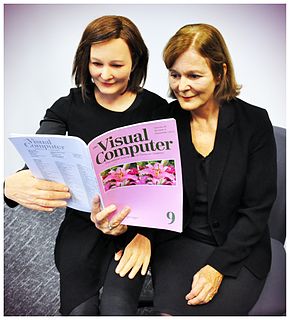Related Research Articles
An android is a robot or other artificial being designed to resemble a human, and often made from a flesh-like material. Historically, androids were completely within the domain of science fiction and frequently seen in film and television, but recent advances in robot technology now allow the design of functional and realistic humanoid robots.
A humanoid robot is a robot with its body shape built to resemble the human body. The design may be for functional purposes, such as interacting with human tools and environments, for experimental purposes, such as the study of bipedal locomotion, or for other purposes. In general, humanoid robots have a torso, a head, two arms, and two legs, though some forms of humanoid robots may model only part of the body, for example, from the waist up. Some humanoid robots also have heads designed to replicate human facial features such as eyes and mouths. Androids are humanoid robots built to aesthetically resemble humans.
Affective computing is the study and development of systems and devices that can recognize, interpret, process, and simulate human affects. It is an interdisciplinary field spanning computer science, psychology, and cognitive science. While some core ideas in the field may be traced as far back as to early philosophical inquiries into emotion, the more modern branch of computer science originated with Rosalind Picard's 1995 paper on affective computing and her book Affective Computing published by MIT Press. One of the motivations for the research is the ability to give machines emotional intelligence, including to simulate empathy. The machine should interpret the emotional state of humans and adapt its behavior to them, giving an appropriate response to those emotions.
A feed forward, sometimes written feedforward, is an element or pathway within a control system that passes a controlling signal from a source in its external environment to a load elsewhere in its external environment. This is often a command signal from an external operator.

A facial recognition system is a technology capable of matching a human face from a digital image or a video frame against a database of faces. Researchers are currently developing multiple methods in which facial recognition systems work. The most advanced face recognition method, which is also employed to authenticate users through ID verification services, works by pinpointing and measuring facial features from a given image.

David Hanson Jr. is an American roboticist who is the founder and Chief Executive Officer (CEO) of Hanson Robotics, a Hong Kong-based robotics company founded in 2013.
In artificial intelligence, an embodied agent, also sometimes referred to as an interface agent, is an intelligent agent that interacts with the environment through a physical body within that environment. Agents that are represented graphically with a body, for example a human or a cartoon animal, are also called embodied agents, although they have only virtual, not physical, embodiment. A branch of artificial intelligence focuses on empowering such agents to interact autonomously with human beings and the environment. Mobile robots are one example of physically embodied agents; Ananova and Microsoft Agent are examples of graphically embodied agents. Embodied conversational agents are embodied agents that are capable of engaging in conversation with one another and with humans employing the same verbal and nonverbal means that humans do.
Human–robot interaction is the study of interactions between humans and robots. It is often referred as HRI by researchers. Human–robot interaction is a multidisciplinary field with contributions from human–computer interaction, artificial intelligence, robotics, natural language understanding, design, humanities and social sciences.

Rosalind Wright Picard is an American scholar and inventor who is Professor of Media Arts and Sciences at MIT, founder and director of the Affective Computing Research Group at the MIT Media Lab, and co-founder of the startups Affectiva and Empatica. In 2005, she was named a Fellow of the Institute of Electrical and Electronics Engineers for contributions to image and video analysis and affective computing. In 2019 she received one of the highest professional honors accorded an engineer, election to the National Academy of Engineering for her contributions on affective computing and wearable computing.

iCub is a 1 metre tall open source robotics humanoid robot testbed for research into human cognition and artificial intelligence.
Robot ethics, sometimes known as "roboethics", concerns ethical problems that occur with robots, such as whether robots pose a threat to humans in the long or short run, whether some uses of robots are problematic, and how robots should be designed such that they act 'ethically'. Alternatively, roboethics refers specifically to the ethics of human behavior towards robots, as robots become increasingly advanced. Robot ethics is a sub-field of ethics of technology, specifically information technology, and it has close links to legal as well as socio-economic concerns. Researchers from diverse areas are beginning to tackle ethical questions about creating robotic technology and implementing it in societies, in a way that will still ensure the safety of the human race.
Adaptable robotics are generally based in robot developer kits. This technology is distinguished from static automation due to its capacity to adapt to changing environmental conditions and material features while retaining a degree of predictability required for collaboration. The degree of adaptability is demonstrated in the way these can be moved around and used in different tasks. Unlike static or factory robots, which have pre-defined way of operating, adaptable robots can function even if a component breaks, making them useful in cases like caring for the elderly, doing household tasks, and rescue work.
For any mobile device, the ability to navigate in its environment is important. Avoiding dangerous situations such as collisions and unsafe conditions comes first, but if the robot has a purpose that relates to specific places in the robot environment, it must find those places. This article will present an overview of the skill of navigation and try to identify the basic blocks of a robot navigation system, types of navigation systems, and closer look at its related building components.
Motor babbling is a process of repeatedly performing a random motor command for a short duration. The concept has its roots from the motion process of human infants, during the period of acquiring their own body models as sensor-motor relationships. In robotics, it is a system of robot learning whereby a robotic system can autonomously develop an internal model of its self-body and its environment.
Educational robotics teaches the design, analysis, application and operation of robots. Robots include articulated robots, mobile robots or autonomous vehicles. Educational robotics can be taught from elementary school to graduate programs. Robotics may also be used to motivate and facilitate the instruction other, often foundational, topics such as computer programming, artificial intelligence or engineering design.

Irfan Aziz Essa is a professor in the School of Interactive Computing of the College of Computing, and adjunct professor in the School of Electrical and Computer Engineering at the Georgia Institute of Technology. He is an associate dean in Georgia Tech's College of Computing and the director of the new Interdisciplinary Research Center for Machine Learning at Georgia Tech (ML@GT).

Oussama Khatib is a roboticist and a professor of computer science at Stanford University, and a Fellow of the IEEE. He is credited with seminal work in areas ranging from robot motion planning and control, human-friendly robot design, to haptic interaction and human motion synthesis. His work's emphasis has been to develop theories, algorithms, and technologies, that control robot systems by using models of their physical dynamics. These dynamic models are used to derive optimal controllers for complex robots that interact with the environment in real-time.

Nadine is a female humanoid social robot that is modelled on Professor Nadia Magnenat Thalmann. The robot has a strong human-likeness with a natural-looking skin and hair and realistic hands. Nadine is a socially intelligent robot which returns a greeting, makes eye contact, and can remember all the conversations had with it. It is able to answer questions autonomously in several languages, simulate emotions both in gestures and facially, depending on the content of the interaction with the user. Nadine can recognise persons it has previously seen, and engage in flowing conversation. Nadine has been programmed with a "personality", in that its demeanour can change according to what is said to it. Nadine has a total of 27 degrees of freedom for facial expressions and upper body movements. With persons it has previously encountered, it remembers facts and events related to each person. It can assist people with special needs by reading stories, showing images, put on Skype sessions, send emails, and communicate with other members of the family. It can play the role of a receptionist in an office or be dedicated to be a personal coach.

Mary-Anne Williams FTSE is an Australian academic, Distinguished Research Professor at University of Technology Sydney, Fellow at CODEX at Stanford University, and Director of the UTS Magic Lab. In October 2020 Distinguished Professor Williams was named the Michael Crouch Chair for Innovation at the University of New South Wales Business School.

The MICCAI Society is a professional organization for scientists in the areas of Medical Image Computing and Computer Assisted Interventions. Due to the multidisciplinary nature of these fields, the society brings together researchers from several scientific disciplines. including computer science, robotics, physics, and medicine. The society is best known for its annual flagship event, The MICCAI Conference, which facilitates the publication and presentation of original research on MICCAI-related topics. However, the society provides endorsements and sponsorships for several scientific events each year.
References
- 1 2 Tapus, Adriana; André, Elisabeth; Martin, Jean-Claude; Ferland, François; Ammi, Mehdi (2015-10-27). Social Robotics: 7th International Conference, ICSR 2015, Paris, France, October 26-30, 2015, Proceedings. Cham, Switzerland: Springer. p. 667. ISBN 9783319255538.
- 1 2 3 Carbone, Giuseppe; Gomez-Bravo, Fernando (2015). Motion and Operation Planning of Robotic Systems: Background and Practical Approaches. Cham: Springer. p. 418. ISBN 9783319147048.
- ↑ Padois, Vincent; Bidaud, Philippe; Khatib, Oussama (2013). Romansy 19 - Robot Design, Dynamics and Control: Proceedings of the 19th CISM-IFtomm Symposium . Wien: Springer Science & Business Media. pp. 152. ISBN 9783709113783.
- 1 2 Ge, Shuzhi Sam; Khatib, Oussama; Cabibihan, John-John; Simmons, Reid; Williams, Mary Anne (2012). Social Robotics: 4th International Conference, ICSR 2012, Chengdu, China, October 29-31, 2012, Proceedings . Heidelberg: Springer. pp. 36. ISBN 9783642341021.
- ↑ Ceccarelli, Marco; Glazunov, Victor A. (2014-06-02). Advances on Theory and Practice of Robots and Manipulators: Proceedings of Romansy 2014 XX CISM-IFToMM Symposium on Theory and Practice of Robots and Manipulators. Cham: Springer. p. 246. ISBN 9783319070575.
- ↑ Tapus, Adriana; André, Elisabeth; Martin, Jean-Claude; Ferland, François; Ammi, Mehdi (2015). Social Robotics: 7th International Conference, ICSR 2015, Paris, France, October 26-30, 2015, Proceedings. Cham, Switzerland: Springer. p. 667. ISBN 9783319255538.